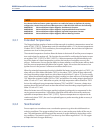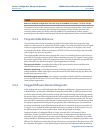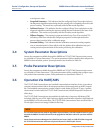
36 Configuration, Startup and Operation
S
ection 3: Configuration, Startup and Operation 6888Xi Advanced Electronics Instruction Manual
December 2012 PN 51-6888Xi
The operator can see if his control recovery actions are having the desired effect. These types of
events do not occur frequently, but knowing the parameters of the situation prevents over-
correcting while coming out of the reducing condition.The stoichiometer feature requires
purchasing the acid resistant stoichiometer cell and the stoichiometer feature inside the 6888Xi.
3.3.3 Programmable Reference
The zirconium oxide sensing technology has historically measured process oxygen by using
ambient or instrument air as a reference (20.95% oxygen). The sensor develops most of its signal
at the low oxygen levels typically found in combustion flue gasses (2-4% oxygen), and is most
accurate at these levels. When measuring near 20.95% O2, the sensor develops only a few milli-
volts of signal, and accuracy degrades.
The programmable reference feature permits the user to use a bottled reference gas of low oxy-
gen value (0.4% oxygen recommended). When measuring at or near 21% oxygen, a strong nega-
tive oxygen signal results, with much improved accuracy. A bottle of reference gas typically lasts
about a month at the low flows required. Typical applications would be:
Flue gas recirculation - controlling the mixing of flue gasses into the burner windbox prior
ahead of the burner to reduce NOx emissions.
Moisture monitoring - measuring the amount of moisture coming off of industrial dryers by
noting the dilution effect water vapor has on the normal 20.95% ambient drying air. (Non-com-
bustion drying processes only.)
Enriched oxygen concentration - pure oxygen is sometimes mixed in with the combustion air
to increase heat at the flame. This is used in steel and other metals reduction processes and in
some catalyst regenerators.
3.3.4 Plugged Diffusion Element Diagnostic
In situ analyzers do very well in high particulate flue gases resulting from processes as such coal
or biofuel boilers, or lime and cement kilns because the passive filter, or "diffusion element" does
not foul or plug off easily. Since the probe sensing cell is inserted entirely into the flue gas stream,
the process gasses can diffuse (migrate) into the cell area with minimal fouling of the filter media.
After many months or years of operation, however, the diffusion element may plug off. The oper-
ator at the DCS console may notice that the O
2
measurement is not as active as previously or that
the speed of response back to the process (purge time) after calibration gases are removed has
increased considerably. A new diffusion element will start to come back to the process value in 3-
5 seconds (T
initial
), and will be all the way back to the process reading in 30-40 seconds (T
final
). As
the diffuser plugs off over many months, these times will get longer and longer.
Another indication of a plugged diffuser is a large increase of the "cell constant" after a
calibration. A slower speed of response not only delays O
2
information for the operator or the
automatic O
2
trim control loop, it can also cause technicians to induce a calibration error while
doing calibrations. Published specifications call for a 5 SCFH flow of calibration gases with a new
diffuser. This slightly pressurizes the cell area with cal gas, ensuring that no flue gases mix in with
the calibration test gasses. As the diffuser plugs off over time, the calibration flow rate will drop
NOTE
Make sure the DCS is configured for the same range as the 6888Xi. For instance: -1% O2 to 10% O2.


















